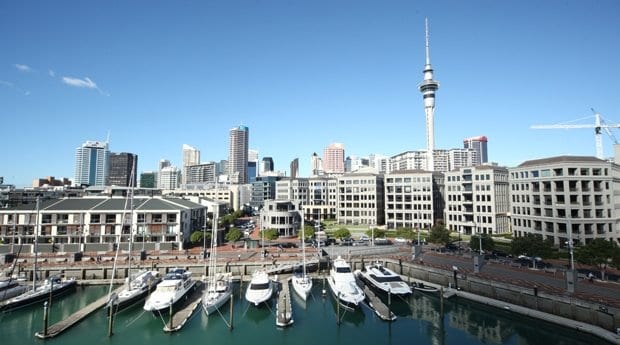
Visit a few of the harbour islands, accessible by ferry from Auckland’s marina. Credit: Michael Luongo
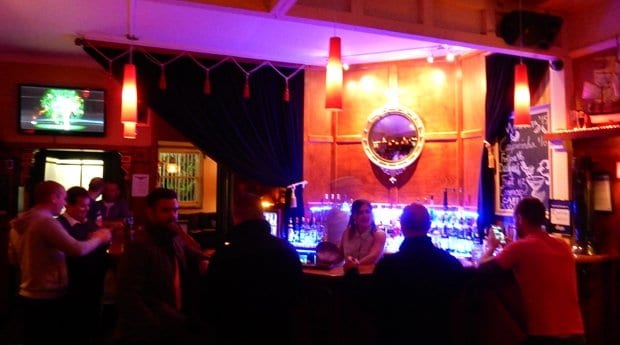
The oddly beautiful Eagle, which rather than a leather bar resembles a captain’s lounge, with wood panels and rounded Neo-Regency mirrors. Credit: Michael Luongo
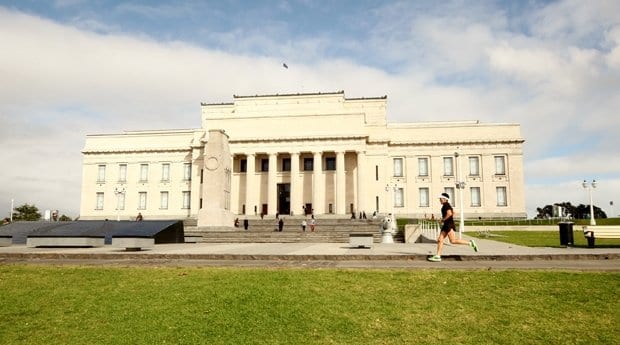
Victoria Park, surrounding the Auckland War Memorial Museum, is home to many Pride festivities. Credit: Michael Luongo
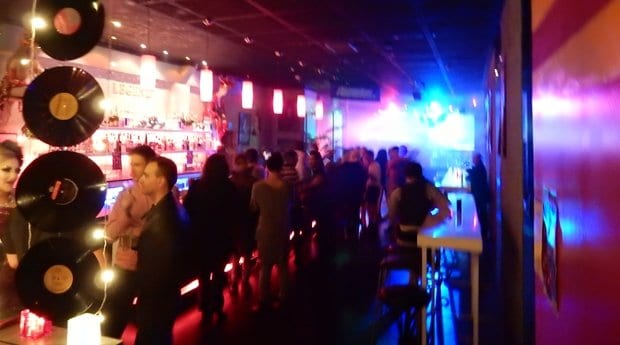
The back of Legend overlooks the Sky Tower. Credit: Michael Luongo
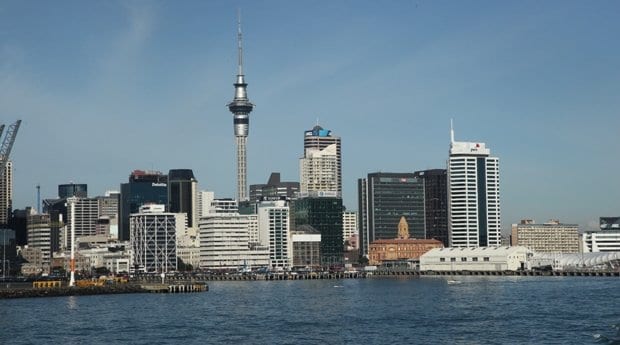
The Auckland skyline. Credit: Michael Luongo
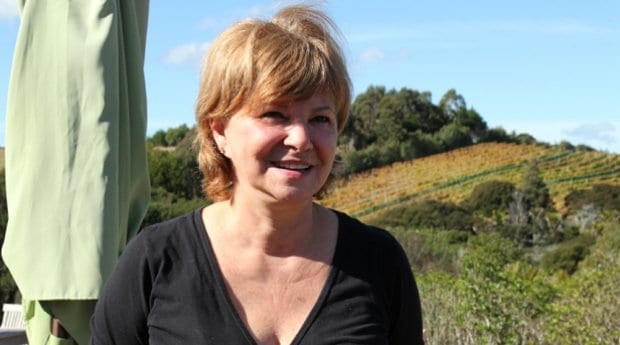
Connie Festa, a Canadian, owns Peacock Sky Vineyard. Credit: Michael Luongo
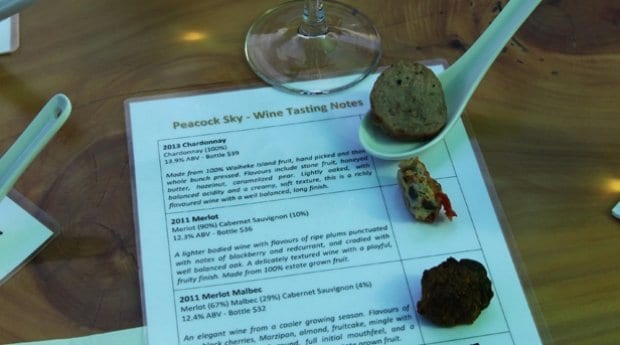
The tasting menu at Peacock Sky Vineyard. Credit: Michael Luongo
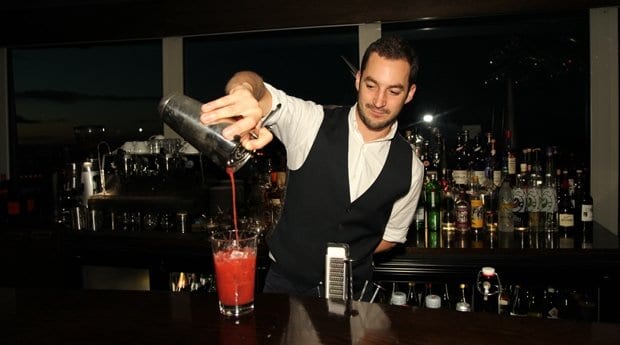
Enjoy panoramic views from the revolving Sugar Club restaurant, atop the 55-storey Sky Tower. Credit: Michael Luongo
The first city that comes to mind when visiting Auckland is Canada’s own Vancouver. Both are clean, modern waterfront cities, wrapped in marinas, surrounded by spectacular nature and blessed with good weather. Auckland, though, just like the entire country of New Zealand, is smaller, more manageable and, dare I say it, even friendlier. I am also told that the city of approximately 1.4 million people has another distinction: one out of four residents is a boat owner, the highest ratio of any major city.
The waterfront is a constant companion on my visit. I stay at the Sofitel Auckland Viaduct Harbour, where every room has a watery vista. The hotel even has a few slips for guests arriving by boat.
The hotel’s location inspires me to take morning jogs, sunrise bringing to life the thousands of boats I pass. Even on less athletic days, I find I am just a short walk away from many of the city’s cultural and dining highpoints, whether in the marina or downtown. Among them is the Voyager Maritime Museum and its many displays, ranging from how the Maori, New Zealand’s indigenous Polynesian people, settled here after colonizing most of the South Pacific, to yachts that have won boating races the world over.
Oceania’s bounty comes to life at the Auckland Fish Market. Another gastronomic highlight, whether you like surf, turf or are strictly vegan, is Ostro, in the Seafarers’ complex, a converted dockside warehouse. Visible from every part of town is the Sky Tower, resembling Toronto’s own CN Tower. Dangle on its walkway 55 storeys above the city or, if you’re less daring, like me, head to Peter Gordan’s Sugar Club, a revolving restaurant at which you can enjoy the same view with a glass of New Zealand sauvignon blanc in hand. Gordon is one of the country’s most important celebrity chefs and has also designed menus for Air New Zealand.
I take a cab to Karangahape Road, the centre of the city’s gay nightlife. You might call it a gentrifying area, though it definitely remains a red-light district. It doesn’t make me feel unsafe, particularly, but it is the only part of Auckland where I feel wary. That said, I am surprised by the density and variety of gay venues here.
Early in the evening, I hit bear bar Urge and the oddly beautiful Eagle, which rather than a leather bar resembles a captain’s lounge, with wood panels and rounded Neo-Regency mirrors. Later, we head to Legend, whose back overlooks the Sky Tower and Family. One of the biggest venues, Family has several areas for dancing, including a small, intimate basement area, with a mix of young straight and gay friends out to have fun — different from the intense, disco-balled main level. A side door leads to a quieter bar area, resembling something you’d find in an American college town, where it’s easier to talk. At Caluzzi Bar and Cabaret, I am too early for a show, but I chat with some of the girls, who tell me the place was once an old-style Italian café, with servers who moonlighted as drag performers nearby. One night, running out of time, they changed into their clothes in the café, equally shocking and delighting patrons. Eventually, drag performances were added and became the focus of the once sleepy, traditional venue.
Getting along and understanding difference is a New Zealand virtue; gay marriage has been legal since 2013. Several years before that, the country elected the world’s first transgender national level politician, Georgina Beyer, whom I first met at the Montreal Gay Games Human Rights Conference in 2006. LGBT awareness began before the British colonists ever arrived. On a Maori tour in Rotorua, a city south of Auckland where the native culture is most intact, I am told that in all of Polynesia the concept of gender variation is something that has long been a tradition. I am taken around by Xquisit Tours and stay at the gay-owned Regent, a former motel turned boutique hotel. The Rotorua Museum, formerly an Edwardian spa resort, touches on gay history and the use of such bathing venues as meeting spots for closeted gay men.
New Zealand is in the Southern Hemisphere, so Auckland Pride takes place in February, in mid-summer. Even what might seem the most stodgy of institutions, the Auckland War Memorial Museum, gets involved, lighting up its classical colonnade in rainbow colours, and the surrounding Victoria Park holds many Pride festivities.
I finish my trip by visiting a few of the harbour islands, accessible by ferry from Auckland’s marina. Among them are the volcanic Rangitoto Island, sacred to the Maori, whose peak offers a stunning view of the city skyline and surrounding islands. A longer ferry ride takes me to Waiheke Island, where I visit Peacock Sky Vineyard, owned by Canadian Connie Festa, and have lunch at Mudbrick Vineyard, where the dining area overlooks the surrounding vineyards. If I ever marry a New Zealander, this is where I want the wedding. If your trip does not include time for the Marlborough wine region on the South Island, definitely visit Waiheke.
I have to note that New Zealand, even in the heart of Auckland, has the freshest, cleanest air of any major developed country I have been to. New Zealand often is grouped with Australia, but like Canada to the United States, in spite of what might seem similar cultures, it’s a very different place.
Visit Auckland Tourism and New Zealand Tourism.
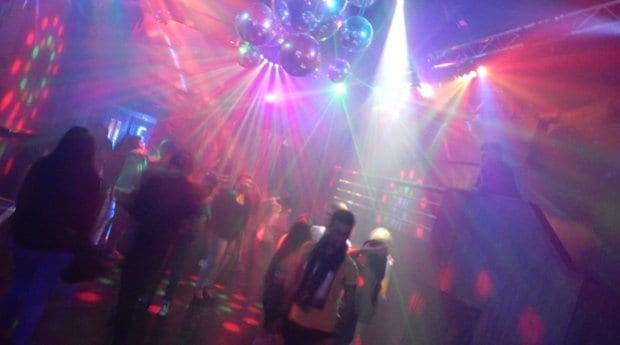
 Why you can trust Xtra
Why you can trust Xtra